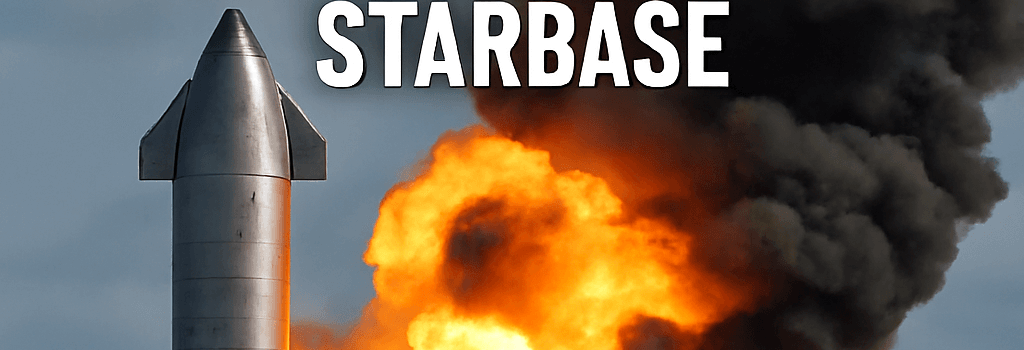SpaceX Starship Prototype Fails Ground Test at Starbase

Test Stand Explosion Overview
Late Wednesday night at Starbase in South Texas, SpaceX’s latest Starship prototype, Ship 36, experienced a catastrophic failure during a static fire test at the company’s Massey’s Test Site. Live-streamed footage from LabPadre and NASASpaceflight.com captured a towering fireball as Ship 36’s bullet-shaped upper stage erupted in flames shortly after methane and super-cold liquid oxygen propellants reached tank pressures above 8 bar. The incident damaged ground support equipment and set off secondary fires across the test pad area, though SpaceX confirms no injuries occurred.
Preliminary Cause Analysis
Propellant Loading and Pressurization Systems
According to telemetry, Ship 36’s six Raptor 2 engines were nearing ignition sequence when a sudden overpressure event in the liquid oxygen manifold triggered a rapid discharge through the vent stacks. Super-cold propellant temperatures (LOX at –183°C, CH4 at –162°C) can induce brittle fractures in exposed plumbing if pressurization valves malfunction. SpaceX engineers suspect a failed check valve or sensor calibration drift led to localized overpressure, compromising nearby insulation and structural supports.
Engine Ignition Sequence and Data Telemetry
Data logs show the Raptor engines began pre-burner spin-start at T-3 seconds, but pressure spikes in Engine 2’s feed line caused an automatic shutdown command. Within milliseconds, unspent propellant pooled near the thrust puck and ignited upon contact with residual hot gas. High-speed cameras captured shrapnel ejection and a flame front propagating across the aft dome of the vehicle.
“The resonance frequency of the feed system must be decoupled from the engine start harmonic,” notes Dr. Jane Smith, a propulsion expert at the California Institute of Technology. “SpaceX’s previous failures hint at structural acoustics playing a bigger role than thermal stresses alone.”
Structural Integrity and Materials Science
Ship 36 incorporated upgraded stainless steel alloy 301 plates, selected for improved high-temperature yield strength during atmospheric reentry. However, the alloy’s behavior under cryogenic cycling remains under evaluation. Finite element analyses (FEA) are now being rerun with updated material properties to assess brittle fracture thresholds at weld joints and tank intercepts. Engineers will also examine the new copper-nickel heat shield tiles, each rated for 1,600°C, to verify thermal expansion coefficients did not contribute to joint separation.
Propulsion System Diagnostics and Upgrades
SpaceX’s Raptor 2 engine delivers 230 metric tons of thrust at sea level and features an optimized full-flow staged combustion cycle. The company plans to integrate upgraded high-pressure turbopumps with ceramic ball bearings and enhanced gas-generator flow passages in future builds. These changes aim to reduce the likelihood of turbine blade flutter and improve margins against cavitation during propellant spin-start.
- Engine Thrust: 2.3 MN each at SL, 2.6 MN in vacuum
- Propellant Mass: 1,200 metric tons total (super heavy + Starship)
- Tank Pressurization: 8.5 bar nominal, up to 9.5 bar test conditions
- Ignition System: Spark-torch igniters with redundant cross-feed circuitry
Risk Management and Testing Protocols
Massey’s Test Site is SpaceX’s lone proof-test facility, sitting on a Rio Grande bend near the border. The explosion underscores the criticality of distributed ground support networks and remote operations. SpaceX is now evaluating alternative test locations, including its Boca Chica pad and a potential second stand at the McGregor facility in Texas. The company may also accelerate the use of simulators and digital twins to validate pressurization sequences before cryogenic loads are applied.
- Review of sensor calibration and redundancy in feed lines.
- Enhanced remote-operator safing procedures with AI-driven anomaly detection.
- Accelerated construction of a backup static fire stand at McGregor.
Programmatic Implications and Next Steps
This setback pushes SpaceX’s ambitious 2025 orbital flight attempt further into 2026. The FAA has opened a formal investigation, delaying the previously penciled-in June 29 launch window. Meanwhile, NASA’s in-space refueling demonstration contract has slipped, and Artemis landing timelines face additional pressure. SpaceX will likely ship a replacement Starship (Ship 37) to Starbase within weeks, pending parts availability and factory capacity.
Expert Perspectives and Industry Context
“Starship represents the most complex reusable launch system ever attempted,” says Mark Rogers, aerospace analyst at Euroconsult. “Each failure yields terabytes of data, but program cadence slows when infrastructure is out of service. SpaceX must balance rapid iteration with robust ground-support reliability.”
Competitors like Blue Origin and ULA are watching closely. Blue Origin’s New Glenn rocket, set for a maiden flight in late 2025, faces its own engine certification hurdles. Meanwhile, ULA’s Vulcan and ArianeGroup’s Ariane 6 are stepping into the heavy-lift market, emphasizing modularity and incremental risk reduction over radical redesigns.
Looking Ahead: Roadmap to Mars and the Moon
Despite the explosion, SpaceX’s roadmap remains intact: achieve orbital Starship flight, develop cryogenic orbital refueling, and conduct a NASA-contracted lunar landing by 2027. Elon Musk has reiterated plans to dispatch the first crewed Mars mission in 2028, contingent on mastering rapid Starship reuse and deep space life-support integration. The next quarter will test SpaceX’s resilience in hardware development, regulatory compliance, and supply chain agility.